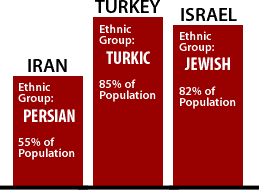 |
 |
|
|
|
Pick a Region:. . The Middle East
It is important to note that at this time there is no state of Palestine--only territories (the Gaza Strip and portions of the West Bank) within the Middle East that are controlled by the Palestinian National Authority. The peoples of the Middle East can be differentiated on the basis of their ethnicity, religion, and national identity. Ethnicity Originally, the term "Arab" referred to the peoples that inhabited the northern and central portions of the Arabian Peninsula. Following the spread of various Arab-Islamic empires throughout the Middle East and into Europe and south Asia (see History), the term "Arab" has come to be synonymous with those who speak Arabic. Presently, about 60% of the total population in the Middle East speak Arabic and consider themselves to be an Arab. In addition to Arabs, there are a number of other ethnic groups in the Middle East. The chart below lists the states in the Middle East that do not have an Arab majority, the ethnic group that makes up the majority, and the percent of the population each ethnic group has within its particular state. 
Another significant ethnic group would be the Kurds, who exist as a minority population distributed throughout Iraq, Syria, Iran, and Turkey. Religion According to the list of states, the Middle East is almost uniformly populated by Muslims. However, this apparent uniformity of religion masks a number of important distinctions. For instance, there are a number of different sects within Islam. Most people in the Middle East belong to the Sunni sect of Islam. Another sect, Shiite or Shia Islam, is the majority religion in Iran, Lebanon, Iraq and Bahrain. There are also Shiite minorities in Lebanon, Kuwait, and Yemen. Other smaller sects also exist within Islam. These sects include, among others, the Alawites, the Druze, the Ibadis, the Ismailis, the Shafis, and various Sufi orders. Islam is practiced in other countries besides the Middle Eastern states listed above. Over the centuries Islam spread far and wide, through Asia and Africa, and even to parts of Europe. This spreading of Islam has resulted in Islam becoming the dominant religion in non-Middle Eastern states such as Afghanistan, Pakistan, Bangladesh, Malaysia, and Indonesia. There are also large numbers of Muslims in the Philippines, China, the former Yugoslavia, Ethiopia, Nigeria, parts of Europe, and even the United States. In fact, more Muslims live outside the Middle East than within. In addition to Islam, other religions are practiced in the Middle East. For example, in Israel 82% of the population are Jews who practice Judaism. Israel the only state in the Middle East where Islam is not the majority faith. Christianity is also practiced in the region, especially in such states as Lebanon, Egypt, and Israel. National Identity |
|
|
|
Privacy Statement and Copyright © 1999-2002 by Wheeling Jesuit University/Center for Educational Technologies®. All rights reserved. |
...